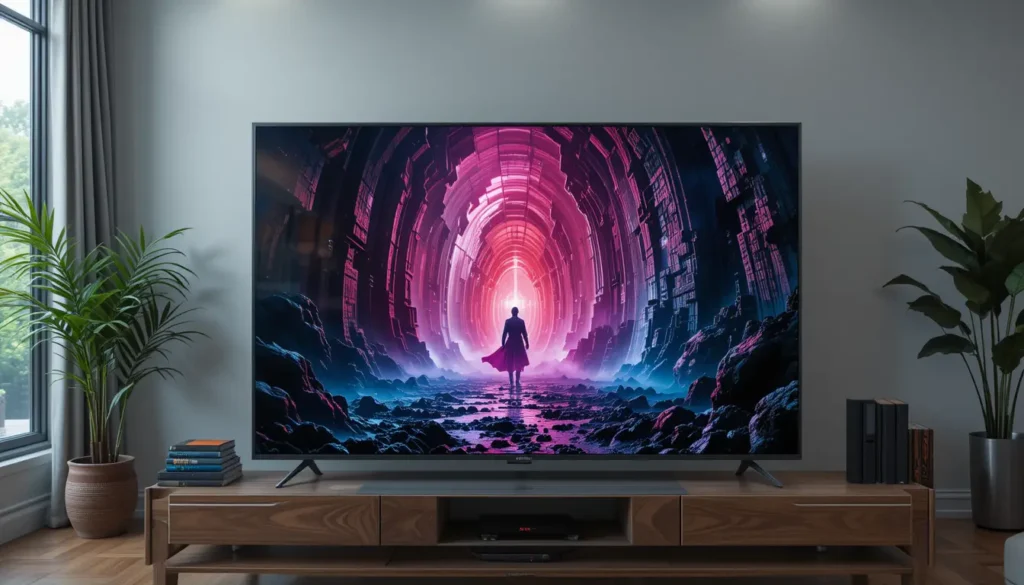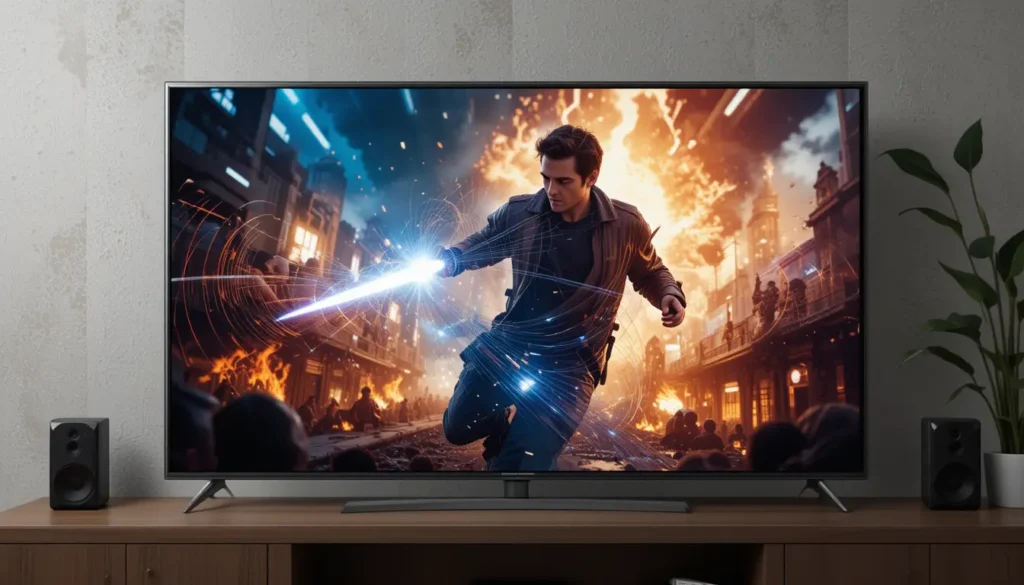LG Evo G5 OLED Review: The Brightest OLED TV Revolutionizing Home Entertainment in 2025
LG Evo G5 OLED Review The Brightest OLED TV
If you’re researching premium TVs and crave unparalleled picture quality that shines in any lighting, the LG Evo G5 OLED stands out as a game-changer. LG pushes OLED technology forward with its innovative Primary RGB Tandem structure, delivering brightness levels that rival mini-LED sets while preserving OLED’s signature perfect blacks and infinite contrast. This review dives deep into the G5’s features, performance, and value, helping TV enthusiasts decide if it deserves a spot in their living room. Priced as a flagship model, it targets cinephiles, gamers, and anyone seeking a future-proof 4K TV.

Design and Build Quality: Sleek Gallery-Style Elegance
LG designs the Evo G5 OLED for wall-mounted installations, emphasizing a minimalist “gallery” aesthetic that blends seamlessly with your decor. The TV ships with a flush-mount bracket, allowing it to sit nearly flat against the wall—like a piece of art. Measuring just 27.2mm thick in the 55-inch model, it exudes premium build quality with a brushed metal frame and bezel-less edges that maximize screen real estate.
You won’t find a stand in the box, which might disappoint some users, but LG offers optional stands for $150–$200 depending on size. The rear panel hides most ports under a snap-on cover, keeping things tidy. Key connections include four HDMI 2.1 ports (all supporting 48Gbps bandwidth), Ethernet, coaxial, and USB inputs. Two HDMI ports face sideways for easy access, including the eARC for soundbars.
Weighing around 16.8kg for the 55-inch version, the G5 proves easy to handle during setup. Its anti-reflective coating earns a UL Glare-Free certification, reducing reflections by up to 30% compared to predecessors. This design choice makes the TV versatile for bright rooms, a common pain point for older OLEDs. Overall, LG crafts a TV that prioritizes elegance and functionality, perfect for modern homes.
For more on installation options, check out LG’s official setup guide here.

Picture Quality: Brightness Breakthrough Meets OLED Perfection
The LG Evo G5 OLED redefines what an OLED TV can achieve, thanks to its Four-Stack Primary RGB Tandem panel. Unlike traditional OLEDs or even the previous G4’s Micro Lens Array (MLA) tech, this new structure layers individual red, green, and blue OLED elements for enhanced light output and color purity. LG claims a 45% brightness boost over the G4, and tests confirm peak HDR brightness reaching 2,296 nits. That’s brighter than many QD-OLED competitors and closes the gap with mini-LED TVs.
In real-world viewing, the G5 excels across content types. It handles SDR content at 465 nits, ensuring vibrant visuals even in well-lit environments. HDR performance shines with Dolby Vision, HDR10, and HLG support, delivering punchy highlights without blooming. Colors pop with 100% fidelity and volume, covering the DCI-P3 gamut almost perfectly—Delta-E scores hover around 1.99 for accurate reproduction.
The Alpha 11 AI Processor Gen2 powers intelligent upscaling, sharpening 1080p or lower sources to near-4K quality. Features like AI Picture Pro analyze frames in real-time, optimizing for sharpness and noise reduction. Motion handling impresses with a 0.1ms response time, minimizing blur in fast-action scenes from movies like Dune: Part Two or sports broadcasts.
Black levels remain perfect, creating infinite contrast that makes dark scenes in Oppenheimer feel immersive. The TV’s Brightness Booster Ultimate magnifies pixels for luminous details, while Dynamic Tone Mapping Pro adjusts HDR on the fly. An early Dolby Vision streaming bug has been fixed via firmware update, ensuring flawless playback now.
Off-axis viewing holds up well, with no color shift or tint issues. If you watch in varied lighting, the G5 adapts brilliantly—far better than dimmer OLEDs. For calibration tips, RTINGS.com offers detailed settings here.

Sound Quality: Immersive Audio with Room for Enhancement
LG equips the Evo G5 with a built-in 4.2-channel speaker system delivering 60W of power, enhanced by AI Sound Pro. This tech upmixes stereo to virtual 9.1.2 surround, creating a spacious soundstage. Dolby Atmos support adds height effects, making explosions in action films feel overhead.
In testing, the G5 produces clear dialogue and balanced mids, with decent bass for an integrated setup. It handles orchestral scores in The Matrix with finesse, but lacks the deep rumble of dedicated subwoofers. Volume peaks without distortion, suitable for medium rooms.
For audiophiles, pair it with a soundbar via eARC. LG’s own SC9S or third-party options like the Sonos Arc integrate seamlessly. The TV also supports DTS:X passthrough, a nod to legacy audio formats. While not audiophile-grade alone, the G5’s sound outperforms most slim TVs and complements its visuals effectively.
Explore compatible soundbars on Amazon here.
Smart Features and User Interface: Intuitive and AI-Powered
Running webOS 25, the LG Evo G5 offers a user-friendly interface with quick app access and personalized recommendations. The AI Concierge acts like a virtual assistant, suggesting content based on viewing habits and even troubleshooting issues via voice commands.
Streaming apps abound, including Netflix, Disney+, and Prime Video, all in 4K with HDR. Apple AirPlay 2 and Google Cast enable seamless mirroring from devices. ThinQ AI integrates with smart home ecosystems, controlling lights or thermostats from the remote.
The Magic Remote uses motion controls for pointer navigation, though some prefer traditional buttons. Family profiles allow customized home screens, triggered by voice recognition. Always Ready mode turns the TV into a digital frame for art or photos, including AI-generated images.
Security updates via LG’s Re:New program ensure longevity, with a 5-year panel warranty adding peace of mind. For smart home integration details, visit LG’s ThinQ hub here.
Gaming Performance: A Console and PC Powerhouse
Gamers rejoice—the LG Evo G5 supports 4K at 165Hz, up from 144Hz on the G4, with VRR, ALLM, and low input lag under 10ms. NVIDIA G-Sync and AMD FreeSync Premium eliminate tearing, while HGiG optimizes HDR for games.
All four HDMI 2.1 ports handle high-bandwidth signals, perfect for PS5, Xbox Series X, or PCs. Dolby Vision Gaming enhances titles like Cyberpunk 2077, delivering vivid colors and shadows. Cloud gaming via GeForce Now or Xbox Game Pass streams smoothly.
The Game Dashboard provides quick tweaks without pausing. In bright rooms, the anti-glare screen keeps details sharp during intense sessions. If gaming is your focus, this TV rivals dedicated monitors.
For gaming benchmarks, check CNET’s in-depth analysis here.
Pros and Cons: Weighing the Strengths and Drawbacks
Pros
- Unmatched OLED brightness for versatile viewing
- Stunning color accuracy and infinite contrast
- Top-tier gaming features with 165Hz support
- Sleek design and robust smart ecosystem
- 5-year panel warranty for long-term reliability
Cons
- Premium pricing starts at $3,399 for 65-inch
- No included stand; wall-mount focused
- Built-in sound benefits from external audio
- AI features may feel gimmicky to some users
Conclusion: Is the LG Evo G5 OLED Worth It?
The LG Evo G5 OLED reclaims the throne as the best OLED TV for 2025, blending breakthrough brightness with OLED’s core strengths. It caters perfectly to TV researchers seeking a high-end set for movies, gaming, and everyday use. While the price tag reflects its flagship status, the performance justifies the investment for those who prioritize quality.
Compared to the mid-range C5, the G5 offers superior vibrancy and features, making it ideal for bright rooms or enthusiasts. If budget constrains you, consider the discounted G4. Otherwise, the G5 sets a new standard—grab it if you want the ultimate viewing experience.
Purchase options: Available on LG’s site here or Best Buy here.

